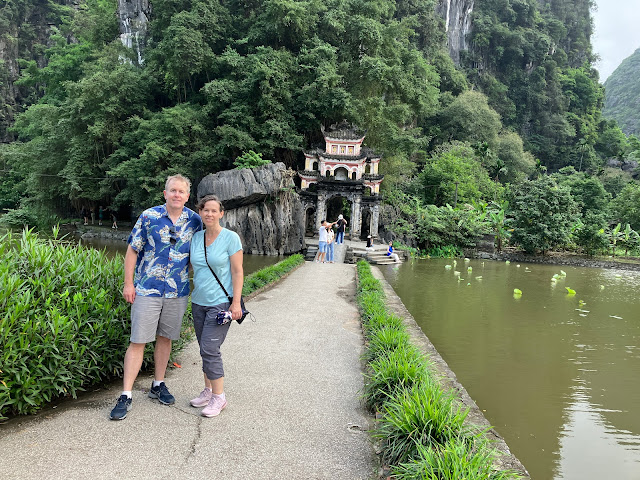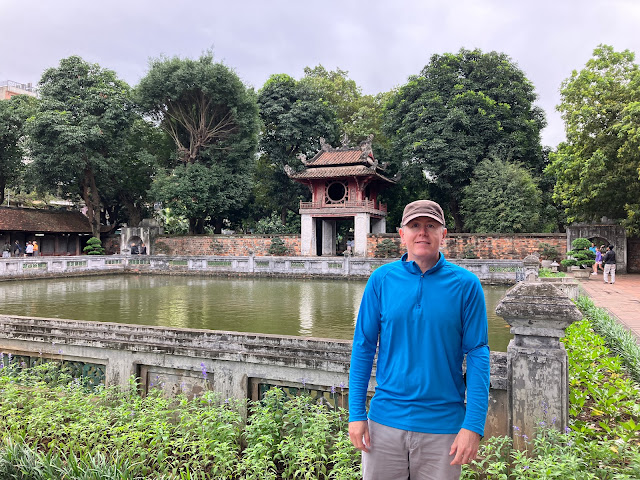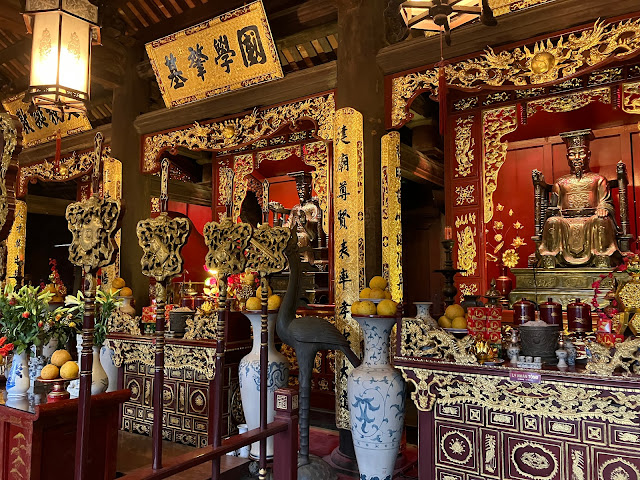This morning we woke up to a deluge of rain, which had us both worried because we had planned an all-day tour that included hiking and biking in the rural Ninh Binh province. As our tour arrived at the Temple of Emperor Dinh Tien Hoang they handed out plastic raincoats but I was glad we’d brought our own umbrellas because it was really coming down!
Luckily we found a somewhat sheltered spot in the temple courtyard. It was a very special Vietnamese holiday, called Hung Kings day, which celebrates the past King/Emperors who used to rule in Vietnam. There have been many dynasties in Vietnam's long history. This particular temple celebrates Dinh Tien Hoang who ruled in the late 10th century. This area, Hoa Lu, was the capital of Vietnam at that time. To commemorate the holiday there was a special procession re-enacting the King Dinh Tien ascending the throne in 968 AD. The man wearing the gold colored robe is re-enacting the part of the king, while the men in red and blue robes are the mandarins and other officials.
In a side chapel at the temple was an elaborate ancestor altar where offerings and incense were placed for the parents of the first Dinh emperor. Most Vietnamese homes have much smaller ancestor altars with photos of the deceased relatives they are honoring. They offer gifts, like a favorite food or drinks, for their loved ones who have passed away. Burning incense then carries the gift to their ancestors in the afterlife.
These adorable girls were performing a song for the holiday celebration at the temple. We caught them rehearsing. The instruments they are playing are two small porcelain teacups in each hand that they clack together in rhythm to the song.
As we left the temple, it was still raining but we were starting to see some bright spots in the clouds in the distance.
The rain stopped just as Our tour van dropped us off at the Hang Mua dragon cave.
This cave was very similar to other caves we've been to recently, so I won't bore you with more cave interior shots. However, we were thrilled that the weather was clearing because this was the stop where the main attraction was to hike up 500 stone steps and get a view of the valley. It was a dizzying walk but the spectacular views were worth every step.
The lotus lake below caught a light-infused reflection of the surrounding mountains.
We were happy because it was just so pleasant to be out in the peaceful countryside after the noisy chaos and insane traffic in Hanoi. This entire scenic area is part of the Trang An UNESCO World Heritage Site.
Hundreds of feet below, we could see a few boats rowing down a scenic stretch of the Ngo Dong River.
We got back in the van to head to the village of Tam Coc closer to the river but we were delayed by an unexpected traffic jam due to water buffalo crossing the road. We were definitely not in Hanoi anymore!
At the river we got into a small rowboat that was being rowed by a friendly local lady named Anh.
The villagers here have always rowed small boats to get to and from the rice paddies that line the riverbanks. What’s remarkable is that most of them don’t row with their arms — instead they use their feet! They still use this mode of transportation to tend the rice, but now they also ferry tourists down and back along a 3.5 kilometer stretch where the river passes under three low caves. The village name Tam Coc translates to "three caves" in Vietnamese.
Here you can see the emerald-colored rice growing beside the river. Thanks to the rain, everything was vibrantly green and lush.
We got to relax on the boat while Anh did all the hard work of rowing, but afterwards we were able to get a bit more exercise by hopping on some bikes and riding a few miles through the countryside.
We ended our ride at the Bich Dong pagoda. We learned that the terms "pagoda" and "temple" aren't interchangeable. A temple is a more general place of worship and veneration, and can be dedicated to real people who lived in the past. However a pagoda is very specific to Buddhism and is like the spiritual home of the Buddha. The Bich Dong pagoda complex was built in 1428. Unfortunately we only got to see the entrance gate because it was time for the 2-hour return journey to Hanoi.
I was so glad we decided at the last minute to book this trip instead of spending another day in Hanoi. For me, the gorgeous scenery was just as pretty as the more heavily touristed Ha Long Bay, and it was very tranquil and peaceful in the village of Tam Coc. Definitely worth a visit, and a wonderful place to explore the more rural village life in Vietnam.























































